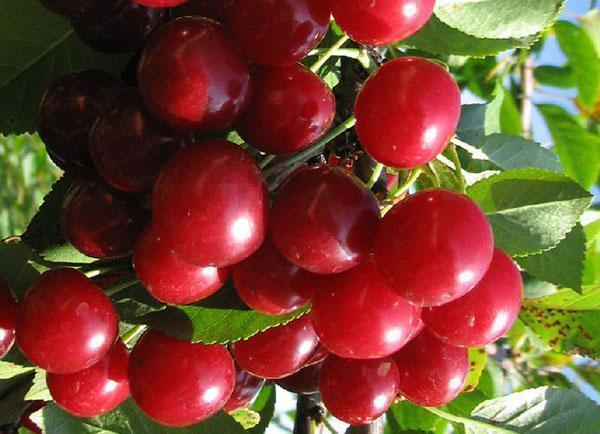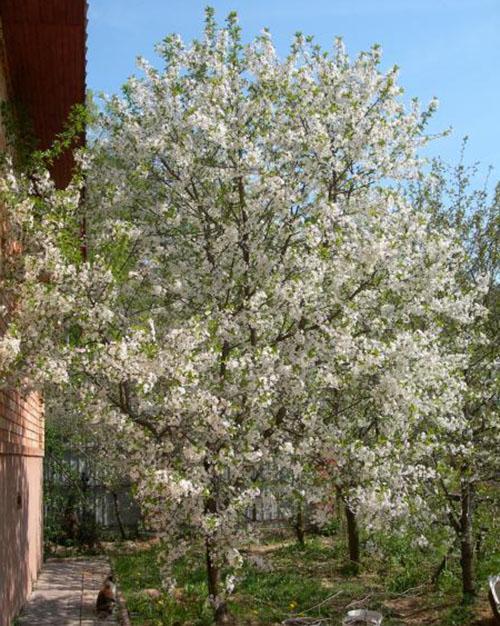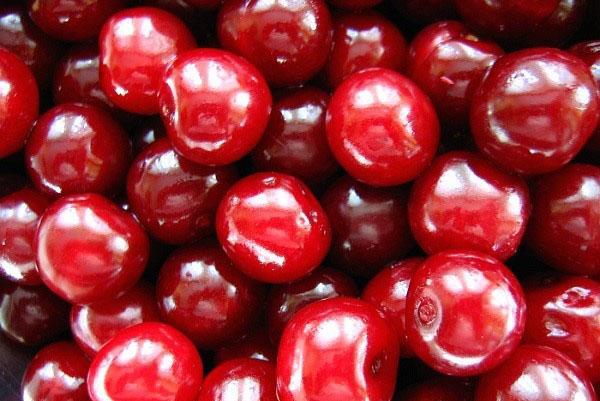Cherry Kharitonovskaya - a good choice of a gardener
 Among the variety of cherry varieties, the middle-ripening Kharitonovskaya cherry, obtained as a result of crossing the Diamond and Zhukovsky varieties, is loved and popular. The first seedlings were grown in 1998. Probably, there are simply no people who do not like cherries, or they can be counted on one hand. Who hasn't tasted cherry dumplings, cherry pie or jelly? What about cherry jam? An experienced (and not so) hostess can cook a lot of dishes with cherries - and countless. And each probably has its own favorite variety, and if not, you must definitely try to grow Kharitonovskaya cherry.
Among the variety of cherry varieties, the middle-ripening Kharitonovskaya cherry, obtained as a result of crossing the Diamond and Zhukovsky varieties, is loved and popular. The first seedlings were grown in 1998. Probably, there are simply no people who do not like cherries, or they can be counted on one hand. Who hasn't tasted cherry dumplings, cherry pie or jelly? What about cherry jam? An experienced (and not so) hostess can cook a lot of dishes with cherries - and countless. And each probably has its own favorite variety, and if not, you must definitely try to grow Kharitonovskaya cherry.
Characteristics of the tree and fruit

The berries are harvested from last year's shoots: they are large, dark red, very juicy, with thin skin and weighing about 5 grams. The stone separates well from the pulp, but with difficulty - from the stalk, although the stalk itself is easy to pick from the tree. On ripe cherries, dots under the skin are poorly visible (see. cherry chocolate - variety description, photos, reviews).
Pros and cons of the variety
 The variety attracts attention because it gives a bountiful harvest and behaves well during transportation. An important factor is that such a cherry is very resistant to various types of diseases, in particular to coccomycosis.
The variety attracts attention because it gives a bountiful harvest and behaves well during transportation. An important factor is that such a cherry is very resistant to various types of diseases, in particular to coccomycosis.
Cherry Kharitonovskaya is a self-fertile variety and does not need additional pollinators.
As for the disadvantages, practicing gardeners note the low frost resistance of the variety in cold winters. Flower buds most often suffer from frost.
Another characteristic feature of the Kharitonov cherry is its increased seed size.
Pick up time and place
 The most suitable time for planting cherries is mid-autumn, or rather October. You can plant it in the spring, but in this case it is important not to miscalculate and be in time before the sap flow begins. When buying a seedling at the very end of autumn (it is advisable to choose a two-year-old, grafted with a cuttings), it is still better to leave it for storage until spring planting. To do this, put the seedling in a trench 40 cm deep, facing south, press it well with earth and water.
The most suitable time for planting cherries is mid-autumn, or rather October. You can plant it in the spring, but in this case it is important not to miscalculate and be in time before the sap flow begins. When buying a seedling at the very end of autumn (it is advisable to choose a two-year-old, grafted with a cuttings), it is still better to leave it for storage until spring planting. To do this, put the seedling in a trench 40 cm deep, facing south, press it well with earth and water.
Cherries are demanding on lighting, so they should be planted on the southern side of the site, especially if there are hills there. For the same reason, you should not choose trees with wide crowns as neighbors, so that they do not interfere with the access of sunlight. Otherwise, the tree will put all its strength into growth, will begin to stretch, which will negatively affect the amount of harvest.
It is advisable to avoid the proximity of groundwater, and if this is not possible, the tree is planted on an artificial hill 1 meter high.
Preparing the soil and holes for planting
 Cherry Kharitonovskaya grows well in loose, neutral soil. When digging into the soil, fertilizers should be applied:
Cherry Kharitonovskaya grows well in loose, neutral soil. When digging into the soil, fertilizers should be applied:
- organic;
- potash;
- phosphoric.
If the acidity of the soil is increased, it is limed so that the seedling does not die.
Remove the damaged roots of the seedling before planting, and soak the dried up roots in water for 4 hours.
The pit should be prepared two weeks before planting. Divide the excavated soil into two piles at once: separately the upper and lower layers. In the middle of the landing pit, install a one and a half meter peg-support, and the size of the pit itself should be 60x60.
The pit also needs to be fertilized and added to it:
- a couple of buckets of humus;
- wood ash;
- calcium sulfate;
- superphosphate granules.
Do not add lime and mineral fertilizers to the planting pit.
Put a seedling in the prepared planting hole, spread the roots and cover first with the upper layer of the dug soil, to which fertilizers were added, and then with the lower one. Make a hole around and pour water (at least 3 buckets), and then loosen.
When planting a seedling, do not completely cover the root collar with soil and make sure that after watering it remains at the soil level.
Care rules
 Cherry variety Kharitonovskaya in care is not capricious. It is enough to water it as needed, loosen the soil after watering, remove weeds and excess shoots, fertilize it with nutrients, and also treat it with pest control agents.
Cherry variety Kharitonovskaya in care is not capricious. It is enough to water it as needed, loosen the soil after watering, remove weeds and excess shoots, fertilize it with nutrients, and also treat it with pest control agents.
As noted for a long time, plants, shrubs and trees growing nearby influence each other's development. In order for the cherry to grow well and bear fruit abundantly, it is advisable to plant “right neighbors” on it. Under the crown you can place raspberries, strawberries, and in the neighborhood - jasmine, roses, grapes, gladioli. It is not recommended to plant apple trees, irises, lilies, daffodils, and also carrots near cherry trees.
Dig up the plot in autumn, fertilize with sawdust, bird droppings, phosphorus and potash fertilizers. The tree itself should be protected from frost and small pests. For rodents, spray the cherries with a mixture of ferrous sulfate, mullein and clay. When winter precipitation appears, cover the seedling with snow, and cover it on top with straw or sawdust.
 With the arrival of spring, remove the dry bark from the cherry, cut off all dry and damaged branches, and cut the young seedlings by 60 cm. Pruning will rejuvenate the cherry and will give the tree crown a beautiful shape, especially for young seedlings. Then paint over the places of the cuts with copper sulfate, and whitewash the tree with slaked lime. Clean the soil under the cherry of fallen leaves and dry grass, and carefully dig it up, trying not to touch the roots.
With the arrival of spring, remove the dry bark from the cherry, cut off all dry and damaged branches, and cut the young seedlings by 60 cm. Pruning will rejuvenate the cherry and will give the tree crown a beautiful shape, especially for young seedlings. Then paint over the places of the cuts with copper sulfate, and whitewash the tree with slaked lime. Clean the soil under the cherry of fallen leaves and dry grass, and carefully dig it up, trying not to touch the roots.
After the end of flowering, fertilize the cherries with a solution of 6 buckets of water, manure and ash, after 2 weeks, re-fertilize.
To control pests at the very beginning of spring, spray the tree with urea diluted in water. Against fungal diseases, Azofos and Bordeaux mixture are widely used (process before flowering).
Water the cherry three times per season. The first time - in the middle of summer, and the next two times - with a break of 1 month.